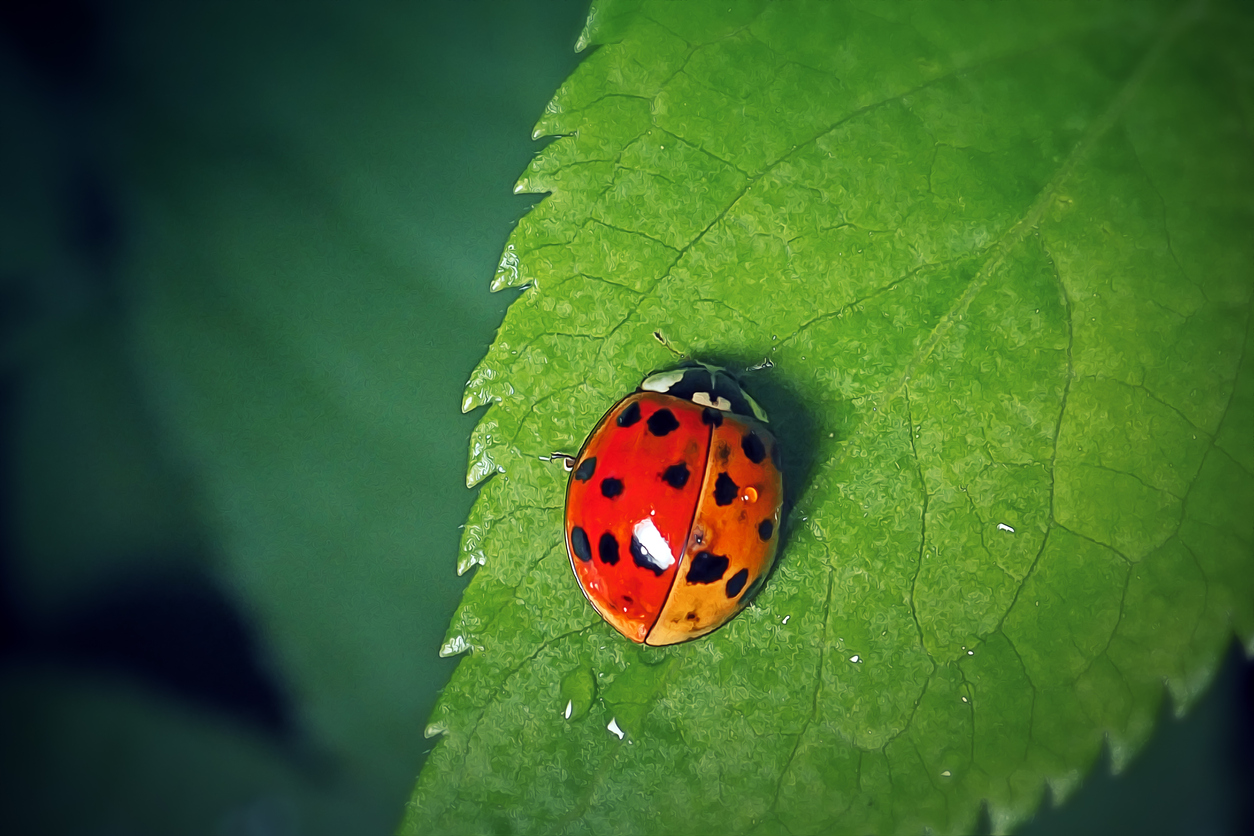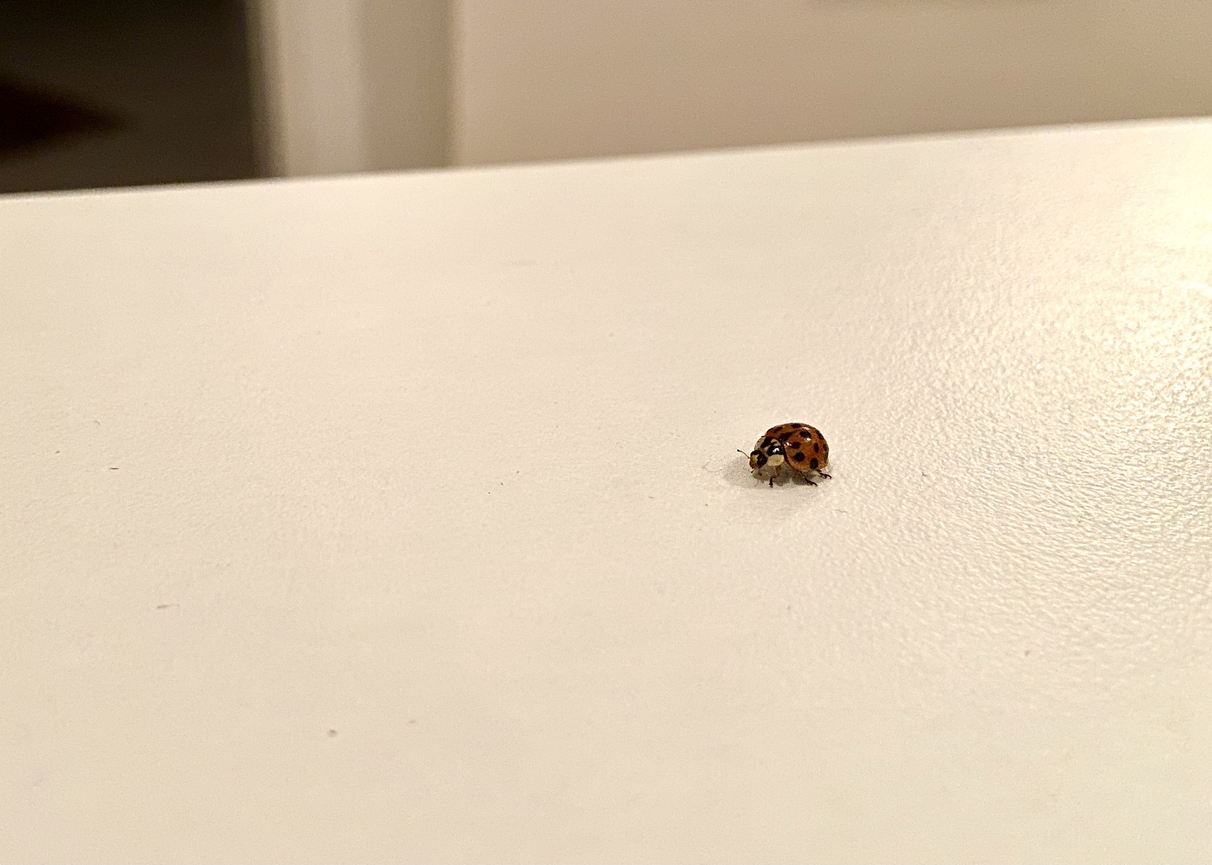Ladybugs
Common Pest: Ladybugs
Lady beetles, commonly known as ladybugs, are one of America’s most popular insects. They are a favorite among children, often the subject of rhymes and thought to bring good luck if one lands on you. The name has its origins in Britain, where the insect became known as “Lady Bird” or “Our Lady’s Bird.” The name “Our Lady” is a biblical reference to the Virgin Mary because she was often depicted in early paintings wearing a scarlet cloak with seven black spots. The name evolved to lady beetle and finally in North America to lady bug. Scientists prefer the proper name lady beetle, since this insect is neither bird nor bug.
There are approximately 5,000 species of ladybugs worldwide
They can be found in most temperate climates. About 400 of those ladybug species are native to North America. Ladybugs are small (about 1mm to 10mm) in size, dome shaped and brightly colored (usually orange, red or yellow to ward off predators). Ladybugs have three main body segments: a head, pronotum and body with three pairs of legs, eyes and antennae. The most recognizable feature of this insect is the elytra which is the hard shell covering with black spots designed to cover their delicate and almost transparent wings. The elytra are elevated before take off and remain extended during flight. When a ladybug flies, it flaps its wings nearly 85 times per second. When stressed, ladybugs secrete a toxin through their joints, a process called “reflex bleeding,” that is poisonous to predators. There is no conclusive evidence of the purpose of the black spots, but researchers have two theories. One, they are used to mimic eyes which are designed to scare predators. Secondly, they are thought to absorb infrared heat so the insect can be more active in a mild climate.
There are approximately 5,000 species of ladybugs worldwide
They can be found in most temperate climates. About 400 of those ladybug species are native to North America. Ladybugs are small (about 1mm to 10mm) in size, dome shaped and brightly colored (usually orange, red or yellow to ward off predators). Ladybugs have three main body segments: a head, pronotum and body with three pairs of legs, eyes and antennae. The most recognizable feature of this insect is the elytra which is the hard shell covering with black spots designed to cover their delicate and almost transparent wings. The elytra are elevated before take off and remain extended during flight. When a ladybug flies, it flaps its wings nearly 85 times per second. When stressed, ladybugs secrete a toxin through their joints, a process called “reflex bleeding,” that is poisonous to predators. There is no conclusive evidence of the purpose of the black spots, but researchers have two theories. One, they are used to mimic eyes which are designed to scare predators. Secondly, they are thought to absorb infrared heat so the insect can be more active in a mild climate.
This insect is active during the day and “sleeps” at night
A ladybug will tuck its head into its pronotum, much like a turtle retracting his head into its shell. If you were to search for them with a flashlight you would find they remain undisturbed during the night. Ladybugs usually live about a year, with some species living as long as two or three years. Ladybugs lay several eggs to over 2,000 in a lifetime. Eggs are deposited in food-rich environments like the under bark of trees, compost piles, the underside of aphid-infested leaves, shrubs, weeds, hollowed out logs and forests. Larvae will emerge from the eggs after incubating for about 5 to 8 days. The larvae will undergo three more growth stages over the next several weeks before becoming adults.
Ladybugs are omnivorous creatures that feast primarily on aphids and scale insects. Also on the menu are white fly, mealy bugs, mites, moth eggs, bollworm, broccoli worm and in some instances, each other. Aphids are considered to be a (microscopic) parasitic insect that lives on the underneath side of a plant leaf. Mother nature has given us a natural control agent against this well entrenched parasitic pest – ladybugs! Just in case this biological predator was ever to be in short supply, researches, biologists and scientists have introduced this insect into the environment in vast numbers. Ladybugs are now raised on farms, sold by green houses, bug stores, nature centers and in catalogues making them available to even novice gardeners. Widespread distribution of ladybug eggs has resulted in population explosions to the point where the control method itself has now become the nuisance.
This insect is active during the day and “sleeps” at night
A ladybug will tuck its head into its pronotum, much like a turtle retracting his head into its shell. If you were to search for them with a flashlight you would find they remain undisturbed during the night. Ladybugs usually live about a year, with some species living as long as two or three years. Ladybugs lay several eggs to over 2,000 in a lifetime. Eggs are deposited in food-rich environments like the under bark of trees, compost piles, the underside of aphid-infested leaves, shrubs, weeds, hollowed out logs and forests. Larvae will emerge from the eggs after incubating for about 5 to 8 days. The larvae will undergo three more growth stages over the next several weeks before becoming adults.
Ladybugs are omnivorous creatures that feast primarily on aphids and scale insects. Also on the menu are white fly, mealy bugs, mites, moth eggs, bollworm, broccoli worm and in some instances, each other. Aphids are considered to be a (microscopic) parasitic insect that lives on the underneath side of a plant leaf. Mother nature has given us a natural control agent against this well entrenched parasitic pest – ladybugs! Just in case this biological predator was ever to be in short supply, researches, biologists and scientists have introduced this insect into the environment in vast numbers. Ladybugs are now raised on farms, sold by green houses, bug stores, nature centers and in catalogues making them available to even novice gardeners. Widespread distribution of ladybug eggs has resulted in population explosions to the point where the control method itself has now become the nuisance.
This insect goes through a phase called “diapause,”
Which is a form of hibernation, when temperatures fall below 60 degrees. They in turn become active when temperatures climb above that level making them among the first insects to appear in the spring and the last in the fall. Ladybugs over winter in buildings and homes, seeking the sunny (south) side of the structure. Ladybugs are not harmful to humans, however they may stain product as a result of excessive reflex bleeding. The large numbers of insect invading a home or building is usually enough to unnerve even the most tolerant of people. Ladybugs may be great in the garden, but an infestation in the home can be a serious nuisance. Let the professionals at Bugs By Brian protect your home from this occasional invader.
This insect goes through a phase called “diapause,”
which is a form of hibernation, when temperatures fall below 60 degrees. They in turn become active when temperatures climb above that level making them among the first insects to appear in the spring and the last in the fall. Ladybugs over winter in buildings and homes, seeking the sunny (south) side of the structure. Ladybugs are not harmful to humans, however they may stain product as a result of excessive reflex bleeding. The large numbers of insect invading a home or building is usually enough to unnerve even the most tolerant of people. Ladybugs may be great in the garden, but an infestation in the home can be a serious nuisance. Let the professionals at Bugs By Brian protect your home from this occasional invader.
St. Louis, Missouri
Email: scheduling@bugsbybrian.com
Call: (636) 394-0101
Location: 1401 Marsh Ave., Ellisville MO 63011
Melbourne, Florida
Email: scheduling@bugsbybrian.com
Call: (321) 674-1665
Location: 3830 S. Highway A1A Suite, 4135 Melbourne Beach, FL 32951
Ready to get started?
We offer free, no obligation estimates for all our pest control services.
Follow us on our social media plateforms


